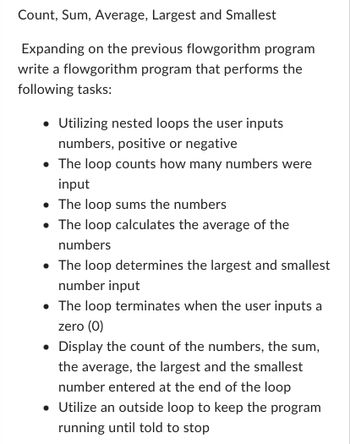
Database System Concepts
7th Edition
ISBN: 9780078022159
Author: Abraham Silberschatz Professor, Henry F. Korth, S. Sudarshan
Publisher: McGraw-Hill Education
expand_more
expand_more
format_list_bulleted
Concept explainers
Question
How to use flowgorithmn for this problem?

Transcribed Image Text:## Count, Sum, Average, Largest and Smallest
### Overview
Expanding on the previous Flowgorithm program, this module teaches students how to write a Flowgorithm program that performs several fundamental numerical tasks. The focus will be on utilizing loops and conditional statements to process a series of numbers. Below are the specific tasks that the program should accomplish:
### Tasks to be Performed by the Program
- **User Input and Loop Initialization:**
- Utilize nested loops to allow the user to input numbers, which can be either positive or negative.
- **Counting Numbers:**
- Count how many numbers are input during the execution of the loop.
- **Summing Numbers:**
- Sum the values of the input numbers.
- **Calculating Average:**
- Calculate the average of the input numbers.
- **Determining Extremes:**
- Determine the largest and smallest number input by the user.
- **Loop Termination:**
- The loop should terminate when the user inputs zero (0).
- **Display Results:**
- At the end of the loop, display the count, sum, average, largest, and smallest number entered.
- **Continuous Execution:**
- Utilize an outer loop to keep the program running until instructed to stop by the user.
### Detailed Program Flow and Execution
#### 1. User Input and Loop Initialization
Using nested loops, prompt the user to input numbers. The input should be recorded and used in subsequent calculations.
#### 2. Counting Numbers
As each number is input, increment a counter to keep track of the total number of inputs.
#### 3. Summing Numbers
Maintain a running total of the sum of all input numbers.
#### 4. Calculating Average
The average can be calculated by dividing the sum of the numbers by the count of numbers, but only after checking that the count is greater than zero to avoid division by zero errors.
#### 5. Determining Extremes (Largest and Smallest Numbers)
For each input, check if it is larger or smaller than the current stored values of the largest and smallest numbers respectively, and update the stored values accordingly.
#### 6. Loop Termination
The main loop should cease when the user inputs the number zero (0), signaling the end of the input sequence.
#### 7. Display Results
Once the loop has terminated, output the count of numbers, the sum, the average, the largest, and the
Expert Solution
This question has been solved!
Explore an expertly crafted, step-by-step solution for a thorough understanding of key concepts.
This is a popular solution
Trending nowThis is a popular solution!
Step by stepSolved in 2 steps with 1 images

Knowledge Booster
Learn more about
Need a deep-dive on the concept behind this application? Look no further. Learn more about this topic, computer-science and related others by exploring similar questions and additional content below.Similar questions
- I need to create a minifloat for a 8 bit binary on c language.arrow_forwardI am attempting to remake a diagram that shows the process of my color mixer program in C++. I have learned a new method of calling functions in a certain order to make the code nicer. I am still having some trouble learning how to make a flow-chart that uses proper shapes and symbols to diagram the program in a flow chart. What are the best practices for the most professional flow-chart? My program is: #include <iostream> #include <fstream> #include <string> #include <limits> using namespace std; string mixColors(int color1, int color2) { string mixedColor; if ((color1 == 0 && color2 == 1) || (color1 == 1 && color2 == 0)) { mixedColor = "purple"; } else if ((color1 == 0 && color2 == 2) || (color1 == 2 && color2 == 0)) { mixedColor = "orange"; } else if ((color1 == 1 && color2 == 2) || (color1 == 2 && color2 == 1)) { mixedColor = "green";…arrow_forwardYou are given the source to an application which crashes when it is run. Afterrunning it ten times in a debugger, you find it never crashes in the same place. The application issingle threaded, and uses only the C standard library. What programming errors could be causingthis crash? How would you test each one?arrow_forward
Recommended textbooks for you
 Database System ConceptsComputer ScienceISBN:9780078022159Author:Abraham Silberschatz Professor, Henry F. Korth, S. SudarshanPublisher:McGraw-Hill Education
Database System ConceptsComputer ScienceISBN:9780078022159Author:Abraham Silberschatz Professor, Henry F. Korth, S. SudarshanPublisher:McGraw-Hill Education Starting Out with Python (4th Edition)Computer ScienceISBN:9780134444321Author:Tony GaddisPublisher:PEARSON
Starting Out with Python (4th Edition)Computer ScienceISBN:9780134444321Author:Tony GaddisPublisher:PEARSON Digital Fundamentals (11th Edition)Computer ScienceISBN:9780132737968Author:Thomas L. FloydPublisher:PEARSON
Digital Fundamentals (11th Edition)Computer ScienceISBN:9780132737968Author:Thomas L. FloydPublisher:PEARSON C How to Program (8th Edition)Computer ScienceISBN:9780133976892Author:Paul J. Deitel, Harvey DeitelPublisher:PEARSON
C How to Program (8th Edition)Computer ScienceISBN:9780133976892Author:Paul J. Deitel, Harvey DeitelPublisher:PEARSON Database Systems: Design, Implementation, & Manag...Computer ScienceISBN:9781337627900Author:Carlos Coronel, Steven MorrisPublisher:Cengage Learning
Database Systems: Design, Implementation, & Manag...Computer ScienceISBN:9781337627900Author:Carlos Coronel, Steven MorrisPublisher:Cengage Learning Programmable Logic ControllersComputer ScienceISBN:9780073373843Author:Frank D. PetruzellaPublisher:McGraw-Hill Education
Programmable Logic ControllersComputer ScienceISBN:9780073373843Author:Frank D. PetruzellaPublisher:McGraw-Hill Education

Database System Concepts
Computer Science
ISBN:9780078022159
Author:Abraham Silberschatz Professor, Henry F. Korth, S. Sudarshan
Publisher:McGraw-Hill Education

Starting Out with Python (4th Edition)
Computer Science
ISBN:9780134444321
Author:Tony Gaddis
Publisher:PEARSON

Digital Fundamentals (11th Edition)
Computer Science
ISBN:9780132737968
Author:Thomas L. Floyd
Publisher:PEARSON

C How to Program (8th Edition)
Computer Science
ISBN:9780133976892
Author:Paul J. Deitel, Harvey Deitel
Publisher:PEARSON

Database Systems: Design, Implementation, & Manag...
Computer Science
ISBN:9781337627900
Author:Carlos Coronel, Steven Morris
Publisher:Cengage Learning

Programmable Logic Controllers
Computer Science
ISBN:9780073373843
Author:Frank D. Petruzella
Publisher:McGraw-Hill Education